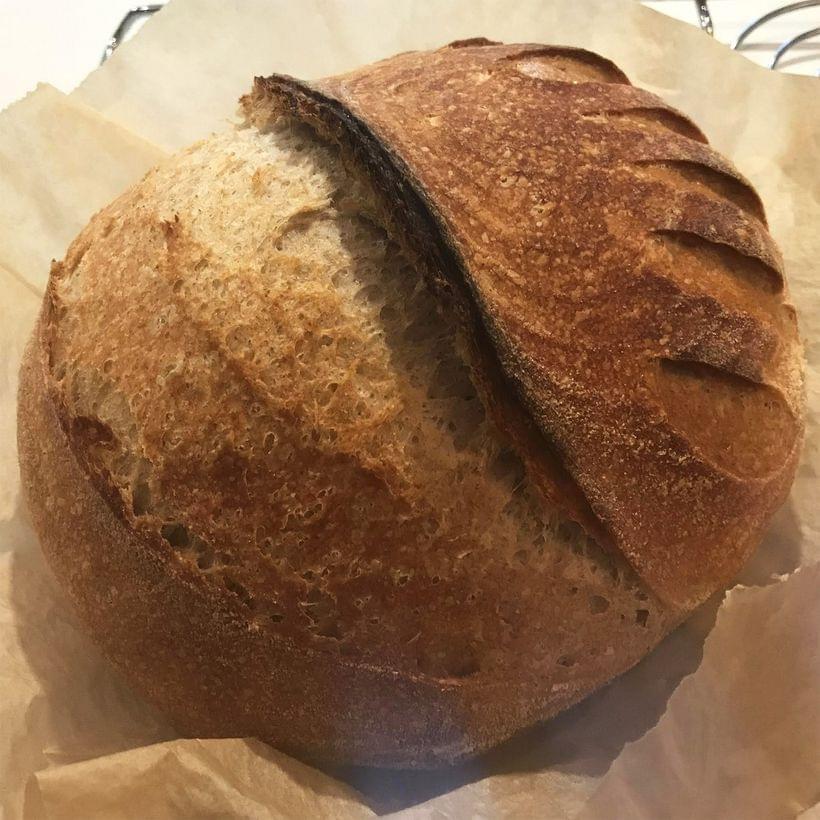Basic Sourdough
Skip to the recipe
This recipe makes a nice little loaf in and of itself, for sure, but with a little remastering it can just as handily become a focaccia, sourdough baguettes, trap remix, whatever. The difference mostly comes down to the ratio of flours, amount of water, and number of airhorns you use.
Before you dive in, you might want to spend a little time with my accompanying everything-there-is-about-bread article. The secret, here, is that this isn’t much of a recipe—no lean bread recipe is much of a recipe. Ultimately, we’re talking about four ingredients, one of which—salt—is technically optional.
Put some flour(s) in a bowl, make ’em damp, introduce some single-celled wildlife: baby, you got a bread goin’.
What’re all these flours?
The first is just bread flour—like all-purpose, but with more gluten-y potential. You can probably get it at the grocery store, but if not, hit up King Arthur or Bob’s Red Mill. Used ’em both, like ’em both.
The second one is whole wheat flour, which adds a little nutty, graham-cracker-y sweetness. Same deal: grocery store stuff, but again, I’ll vouch for both King Arthur and Bob’s Red Mill.
I like to add a little bit of white rye flour, for a little extra bread-y funk. This one is in “special order” territory, but you can definitely go without; just tweak the ratios of the other flours to match—replace the white rye flour with either white or whole wheat, or add a little more of each.
Baker’s Percentages
Anyway, here’s the recipe:
| Ingredients | Baker’s Percentage |
|---|---|
| White flour | 85% |
| Whole wheat flour | 10% |
| White rye flour | 5% |
| Water | 60% |
| Salt | 2% |
| Levain | 12.5% |
—What?
Hey, I warned you. Far be it from me to discourage a little winging it, though; give it hell either way, and let me know how it turns out.
Recipe: Basic sourdough
You can—and should—start tinkering with this recipe as soon as you’ve got the hang of it.
Ingredients
Total Ingredients
-
950 G. Bread flour
-
125 G. Whole wheat flour
-
50 G. White rye flour
-
700 G. Water, between 90°f and 100°f
-
25 G. Starter, fed
-
1/8 C. White rice flour, for dusting
Instructions Levain
-
100 G. Bread flour
-
25 G. Whole wheat flour
-
100 G. Water
-
25 G. Starter
Instructions Final Dough
-
850 G. Bread flour
-
100 G. Whole wheat flour
-
50 G. White rye flour
-
600 G. Water
-
20 G. Salt
-
The entire levain
Instructions
Instructions For the Levain
Add fed starter and lukewarm water to a mixing bowl; swirl until water is cloudy and starter is mostly dispersed. Mix in white and wheat flour until fully incorporated.
Let rest at room temperature, loosely covered, for four to nine hours.
Instructions For the Final Dough
Add entire levain and lukewarm water to a large mixing bowl or the bowl of a stand mixer and swirl until water is cloudy and levain is mostly dispersed. Mix in white and wheat flour until fully incorporated.
Let rest at room temperature, loosely covered, for at least twenty minutes.
Add salt, and machine knead on low speed for four minutes, or hand knead for five minutes. Allow dough to rest for at least ten minutes before performing a windowpane test. If dough tears easily: continue kneading for a few minutes more, allow to rest, and perform the test again.
Remove dough to a lightly oiled bowl or proofing bucket and either mist the dough lightly with spray oil or roll it around the container to prevent drying. Seal the bowl/container with plastic wrap and let rest at room temperature for two hours. Move container to refrigerator and allow to ferment at least overnight, and up to four days.
On baking day, half the total dough, shape into boules and dust with white rice flour or place in round, well-dusted proofing baskets. Allow to proof at room temperature for two hours. In the meantime, place covered Dutch oven into oven and preheat to 500°f.
Move each shaped loaf to a square of parchment paper, and slash. Carefully move dough to Dutch oven—optionally, mist top of the dough with hot water. Return cover to Dutch oven and return to oven for twenty five minutes.
Carefully remove lid from Dutch oven and continue to bake for twenty five minutes, or until the center of the loaf reads 210°f on an instant-read thermometer
Allow bread to rest for at least half an hour before cutting.